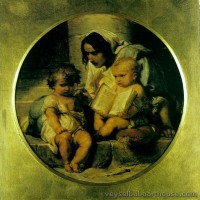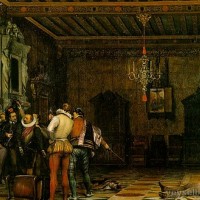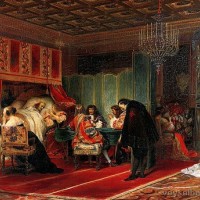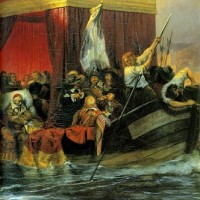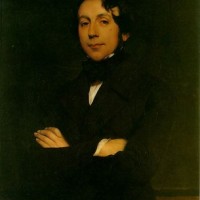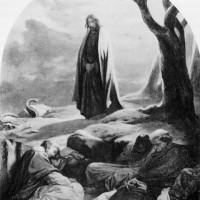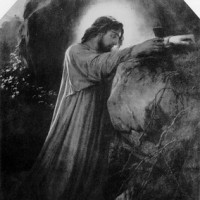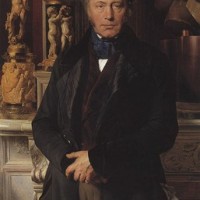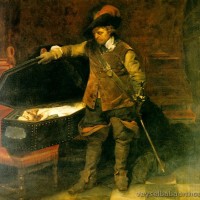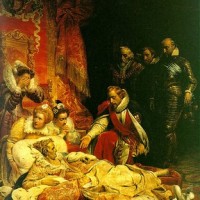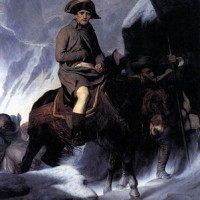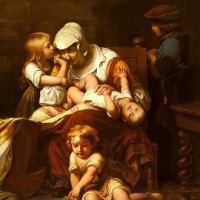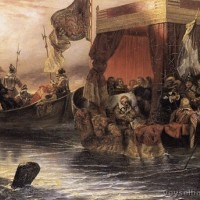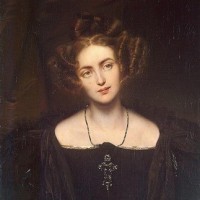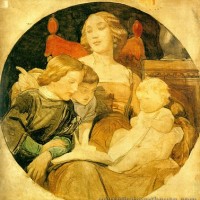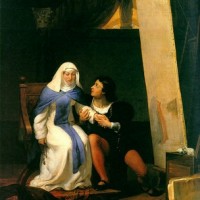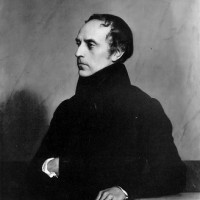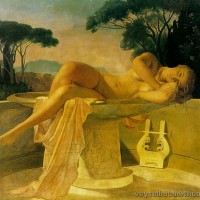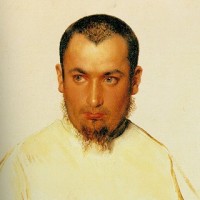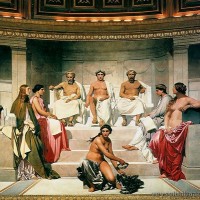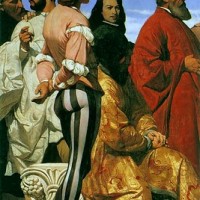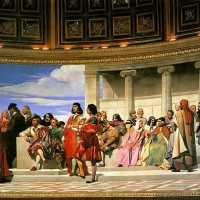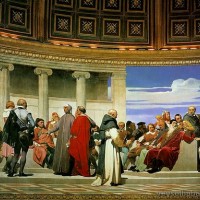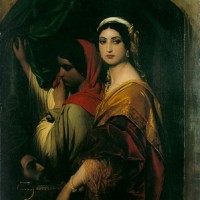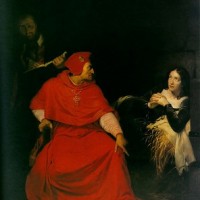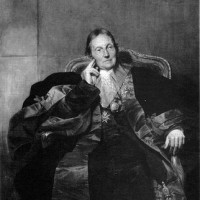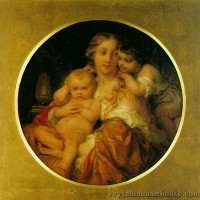- Home
- ABOUT US
- ABOUT VEYSEL BABA
- REDFOX ART HOUSE VIRTUAL TOUR
- MY LAST WILL TESTAMENT
- NOTES ON HUMANITY AND LIFE
- HUMAN BEING IS LIKE A PUZZLE WITH CONTRADICTIONS
- I HAVE A WISH ON BEHALF OF THE HUMANITY
- WE ARE VERY EXHAUSTED AS THE DOOMSDAY IS CLOSER
- NO ROAD IS LONG WITH GOOD COMPANY
- THE ROAD TO A FRIENDS HOUSE IS NEVER LONG
- MY DREAMS 1
- MY DREAMS 2
- GOLDEN WORDS ABOUT POLITICS
- GOLDEN WORDS ABOUT LOVE
- GOLDEN WORDS ABOUT LIFE
- GOLDEN WORDS ABOUT DEATH
- VEYSEL BABA ART WORKS
- SHOREDITCH PARK STORIES
- EXAMPLE LIVES
- ART GALLERY
- BOOK GALLERY
- MUSIC GALLERY
- MOVIE GALLERY
- Featured Article
- Home
- ART GALLERY
- Paul Delaroche
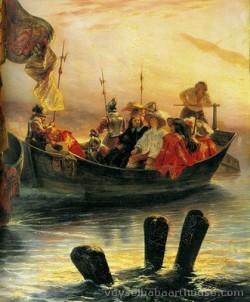
Paul Delaroche
Paul Delaroche (Paris, 17 July 1797 – 4 November 1856) was a French painter who achieved his greater successes painting history. He became famous in Europe for his melodramatic scenes that often portrayed subjects from English and French history. The emotions emphasised in Delaroche's paintings appeal to Romanticism while the detail of his work along with the deglorified portrayal of historic figures follow the trends of Academicism and Neoclassicism. Delaroche aimed to depict his subjects and history with pragmatic realism. He did not consider popular ideals and norms in his creations, but rather painted all his subjects in the same light whether they were historical figures, founders of Christianity, or real people of his time like Napoleon Bonaparte and Marie-Antoinette. Delaroche was a leading pupil of Antoine-Jean Gros and later mentored a number of notable artists like Thomas Couture, Jean-Léon Gérôme, and Francisque Millet.
Delaroche was born into a generation that saw the stylistic conflicts between Romanticism and Davidian Classicism. Davidian Classicism was widely accepted and enjoyed by society so as a developing artist at the time of the introduction of Romanticism in Paris, Delaroche found his place between the two movements. Subjects from Delaroche’s medieval and sixteenth and seventeenth-century history paintings appealed to Romantics while the accuracy of information along with the highly finished surfaces of his paintings appealed to Academics and Neoclassicism. Delaroche’s works completed in the early 1830s most reflected the position he took between the two movements and were admired by contemporary artists of the time—the Execution of Lady Jane Grey (1833; National Gallery, London) was the most acclaimed of Delaroche’s paintings in its day. Later in the 1930s, Delaroche exhibited the first of his major religious works. His change of subject and “the painting’s austere manner” were ill received by critics and after 1837, he stopped exhibiting his work altogether. At the time of his death in 1856, he was painting a series of four scenes from the Life of the Virgin. Only one work from this series was completed: the Virgin Contemplating the Crown of Thorns.
Biography
He was born, worked, and died in Paris. His studio was in the rue Mazarin. His subjects were painted with a firm, solid, smooth surface, which gave an appearance of the highest finish. This texture was the manner of the day and was also found in the works of Vernet, Ary Scheffer, Louis Léopold Robert and Jean Auguste Dominique Ingres. Among his students were British landscape artist Henry Mark Anthony, British history painters Edward Armitage and Charles Lucy, and American painter/photographer Alfred Boisseau (1823–1901).
The first Delaroche picture exhibited was the large Jehosheba saving Joash (1822). This exhibition led to his acquaintance with Théodore Géricault and Eugène Delacroix, with whom he formed the core of a large group of Parisian historical painters. He visited Italy in 1838 and 1843, when his father-in-law, Horace Vernet, was director of the French Academy in Rome. In 1845, he was elected into the National Academy of Design, New York, as an Honorary Academician.
Early Life and Formative Years
Paul Delaroche was born into a family of artists, dealers, collectors, and art administrators. His father, Gregoire-Hippolyte Delaroche, was a prominent art dealer in Paris. Paul Delaroche was the second of two sons and was introduced to fine art at a young age. At age nineteen, Delaroche was afforded by his father the opportunity to study at L'École des Beaux-Arts under the instruction of Louis Étienne Watelet. Delaroche was influenced by his father to focus on landscapes while he was at L’École because his brother, Jules-Hippolyte Delaroche, already focused on painting history. After two years at L’École, Delaroche voiced his disinterest in landscapes and acted on his overall disagreement to the French academic system. He left L'École des Beaux-Art in at the end of 1817. In the year 1818, Delaroche entered the studio of Antoine-Jean Gros (who was trained by David, yet found his greatest success in his un-Davidian productions of contemporary history) where he could pursue his greater interest of history painting.
Artistic Independence
Delaroche’s debuted at the Salon in 1822 where he exhibited Christ Descended from the Cross (1822: Paris, Pal. Royale, Chapelle) and Jehosheba Saving Joash (1822; Troyes, Mus. B.-A. & Archéol). The latter was a product of Gros’s influence and was praised by Géricaultwho supported the beginning of Romanticism. The schooling Delaroche received at L’Ecole des Beaux-Arts tied him to the ideas of Academicism and Neo-Classicism while his time spent in the studio of Gros aroused his interest of history and its representation through Romanticism. His painting, Joan of Arc in Prison (1824; Rouen, Mus. B.-A.), which was exhibited in the Salon of 1824, along with his following works reflect the middle ground he occupied. Delaroche studied the recent tradition of English history painting at the time, which he incorporated into his own productions. In 1828 he exhibited the first of his English history paintings, Death of Queen Elizabeth. Delaroche’s focus on English history achieved him popularity in Britain in the 1830s and 1840s. In the 1930s, Delaroche produced some of his most lauded works, including Cromwell Gazing at the Body of Charles I (1831. Mus. B.-A., Nîmes), The Princes in the Tower (1831, Louvre, Paris) and his most acclaimed piece, the Execution of Lady Jane Grey (1833, NG, London). Recognizing his talent and popularity, the Académie des Beaux-Arts elected Delaroche a member of the society in 1832. A year following, he became a professor at L’Ecole des Beaux-Arts. The same year, he was requested to paint a large mural at the central nave of L'Église de la Madeleine in Paris. Delaroche recognized his lack of experience in religious painting and so travelled for one year in Italy to educate himself on the religious works of the past. Upon his return to France, he was told he was to work with Jules-Claude Ziegler, but abandoned the project altogether thinking that Ziegler would soil the image he already had in mind. In 1837 he exhibited St. Cecilia (1836; London, V&A), which was the first of his significant religious paintings. Delaroche’s change of subject was less impressive to French critics than his previous works.
Style, Themes, and Historical Accuracy
Delaroche as a history painter aimed to present in his work a “philosophical analysis” of a historical event and link it to “the nineteenth-century understanding of historical truth and historical time.” Although there are some discrepencies between history and his history painted, Delaroche saw importance in being faithful to the presentation of facts. German literary critic, Heinrich Heine, says "[Delaroche] has no great predilection for the past in itself, but for its representation, for the illustration of spirit, and for writing history in colours." Delaroche painted all of his subjects in the same light whether they were great historical figures from the past, founders of Christianity, or important political figures of his time like Marie Antoinette or Napoleon Bonaparte. Delaroche carefully researched the costumes and accessories and settings he included in his paintings in order to accurately present his subject. To accentuate historical accuracy, Delaroche painted with meticulous detail and finished his paintings with clear contours. The varying movement of his brush strokes along with the colors and placement of his subjects give each of them a unique appearance and allows them to act in the spirit and tone of their character and the event. The public eye is less observant of fine details and nuances in painting, but Delaroche appreciated the literary value of his paintings over their pictorial value. He balances the literary aspects with the theatricality, narrativity, and visuality of his historical paintings.
The Execution of Lady Jane Grey
Narrativity is Delaroche’s history paintings work to capture an “eternally valid moral truth” rather than the theatricality or “climatic pause” of an ongoing action. Traditional history painting aims to captures a single moment, but Delaroche in his painting, Execution of Lady Jane Grey, creates a bilateral space of time. The executioners of Lady Jane Grey that you see in the painting cannot and do not stand for the original protagonists in the original moment. The figures exist in the same space as the audience and they exist in the same time, but they also exist at the time of the original event. Delaroche does not root the drama of the scene into one moment, but rather extends the emotions felt in the original moment beyond the constraints of time. Théophile Gautier, a French critic of art and literature and a supporter of Romanticism, called the Execution of Lady Jane Grey “cette scène dramatique et mélodramatique” and a scene demonstrative of plot and character.
Historical works and accuracy
His dramatic paintings include Strafford Led to Execution, depicting the English Archbishop Laud stretching his arms out of the small high window of his cell to bless Thomas Wentworth, 1st Earl of Strafford, as Strafford passes along the corridor to be executed, and the Assassination of the duc de Guise at Blois. Another famous work shows Cardinal Richelieu in a gorgeous barge, preceding the boat carrying Cinq-Mars and De Thou carried to their execution. Other important Delaroche works include The Princes in the Tower and La Jeune Martyre (showing a young female martyr floating dead on the Tiber).
Delaroche's work sometimes contained historical inaccuracies. Cromwell lifting the Coffin-lid and looking at the Body of Charles is based on an urban legend, and The Execution of Lady Jane Grey is represented as taking place in a dungeon, which is badly inaccurate. He tended to care more about dramatic effect than historical truth: see also The King in the Guardroom, where villainous Puritan soldiers blow tobacco smoke in the face of King Charles, and Queen Elizabeth Dying on the Ground.
Later works and the close of his career
After 1837, Delaroche stopped exhibiting his work altogether. The disappointing public reception of his painting, St. Cecilia, along with his overall rejection of Davidian values in French society and government led him to his “self-imposed exile from the government-sponsored Salons.” Delaroche then commenced the creation of his most famous work, The Hemicycle, painted on a semicircular saloon at L’Ecole des Beaux-Arts. The Hemicycle was a 27 meter panoramic that included over seventy of the most famous artists since Antiquity. The artists included represent Gothic, Greek, Roman, and Renaissance art. The subjects of this painting appeal to the academic taste of the nineteenth-century. Delaroche paints with encaustic mixtures to create this monumental piece—a technique in which pigment is mixed with hot wax and painted onto the plaster to create a smooth surface. Delaroche did not complete this project alone; four of his students assisted him and together they worked from 1837 to 1841. In 1855 the work was severely damage by fire and Delaroche spent the last year of his life restoring his work. Delaroche died in 1856 and restoration was taken over by Tony Robert-Fleury, a student of Delaroche.
Marriage to Louise Vernet
Delaroche's love for Horace Vernet's daughter Louise was the absorbing passion of his life. He married Louise in 1835, in which year he also exhibited Head of an Angel, which was based on a study of her. It is said that Delaroche never recovered from the shock of her death in 1845 at the age of 31. After her loss he produced a sequence of small elaborate pictures of incidents in Jesus' Passion. He focused attention on the human drama of the Passion, as in a painting where Mary and the apostles hear the crowd cheering Jesus on the Via Dolorosa, and another where St. John escorts Mary home after her son's death.
